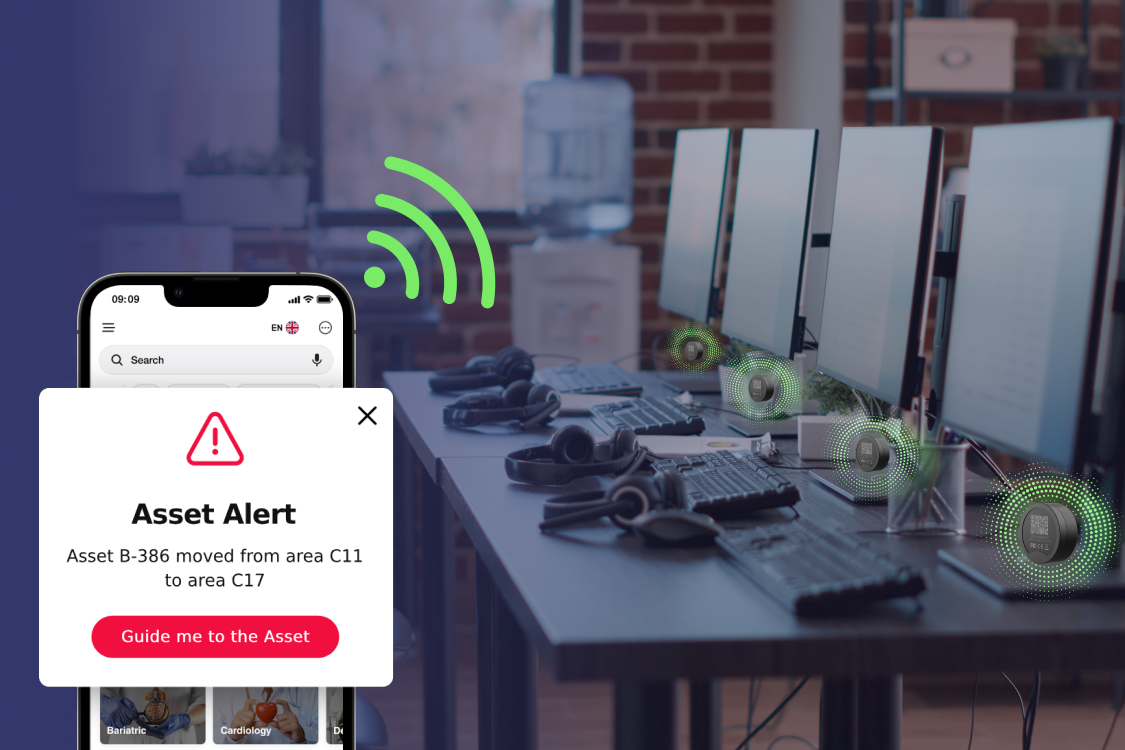IoT Solutions

From manufacturing and healthcare to retail and logistics, indoor asset tracking has become an essential tool for industries to track assets indoors with precision and efficiency. Outdoor tracking systems depend on GPS, but in an indoor environment, there is a necessity for other technologies because satellite signals do not penetrate buildings well enough. This is where Received Signal Strength Indicator (RSSI) comes in. It has been identified as a scalable and cost-effective solution for multiple indoor positioning systems but also has advantages as well as limitations. In this article we will explore the benefits and limitations of RSSI in indoor asset tracking and highlight some innovative alternatives that are redefining indoor asset tracking.
What is RSSI?
RSSI is a measurement of how strong a wireless signal is when received by a device. In the context of indoor asset tracking, RSSI is often used with technologies like Bluetooth or Wi-Fi. The stronger the RSSI value (closer to 0 dBm), the closer the asset is to the receiver. Conversely, a weaker signal (a more negative dBm value) suggests the asset is farther away.
Advantages of RSSI in Indoor Asset Tracking
RSSI presents several compelling advantages for indoor asset tracking:


- Cost-Effectiveness: RSSI-based systems often leverage existing Wi-Fi infrastructure or require minimal additional hardware, making them a budget-friendly option compared to more complex technologies.
- Scalability: RSSI is easily scalable, accommodating everything from small offices to sprawling warehouses.
- Real-Time Tracking: RSSI enables continuous, real-time monitoring of asset locations, providing up-to-the-minute insights.
- Versatility: RSSI is compatible with various wireless technologies, offering flexibility in system design.
Calculations in RSSI-Based Tracking
RSSI-based tracking systems use sophisticated algorithms to convert RSSI values into estimated distances. The most common approach is the log-distance path loss model:
P(d) = A – 2B * log10(d)
Where:
- P(d) is the received signal strength (RSSI) in dBm at distance d
- A and B are environment-specific constants
By measuring RSSI from multiple access points and applying trilateration or other positioning techniques, the system can estimate the asset’s location.
Limitations of RSSI
While RSSI is a valuable tool, it’s important to be aware of its limitations:
- Environmental Factors: Walls, metal objects and even moving people can interfere with RSSI signals, leading to inaccuracies.
- Limited Accuracy: RSSI typically provides zone-level accuracy (within a few meters), which may not be sufficient for applications requiring precise positioning.
- Multipath Fading: In complex indoor environments, radio signals can bounce off surfaces, creating multiple paths and distorting RSSI measurements.
Mapsted’s Minimal Hardware Revolution
Mapsted is at the forefront of location-based technology, offering a groundbreaking hardware-free solution that eliminates the need for beacons, Wi-Fi installations or GPS. Instead, Mapsted leverages a combination of:
- Advanced Machine Learning and AI: Mapsted’s proprietary algorithms analyze data from various sensors (including Bluetooth, Wi-Fi, magnetometer, barometer and more) to deliver precise positioning.
- Crowdsourced Data: Anonymous data from smartphone users contributes to continuously improving the accuracy of Mapsted’s system.
- IoT Sensors: Mapsted can integrate with existing IoT sensors within a building to further enhance positioning accuracy.
In addition, Mapsted’s IoT division excels in both asset tracking and personnel monitoring. Real-time tracking not only enhances the workplace safety and optimizes staff deployment but also reduces the operational costs by efficiently managing workforce allocation. Mapsted’s asset tracking solutions provide critical updates and ensure uninterrupted monitoring, slashing down setup costs and enhancing efficiency.
This unique approach not only simplifies deployment but also provides accuracy down to 1-5 metres, surpassing the limitations of traditional RSSI-only systems.
Conclusion
RSSI remains a viable solution for indoor asset tracking, offering affordability and scalability. Despite its limitations such as limited accuracy and interference, it still is often a popular choice for businesses. But with innovative, enterprise grade, multi-purpose platform solutions available that offer cutting-edge asset tracking as well as onsite navigation, and building analytics and intelligence, allowing them to comprehensively fill multiple needs while achieving business goals, many organizations are turning to Mapsted.
Ready to learn more about innovative asset tracking solutions for your business and provide immersive experiences to your customers, visitors or audience all in one dynamic one-stop shop solution? Contact Mapsted to book a free demo.
If you enjoyed this blog, take a look at our post on The Future of Asset Tracking: Emerging Technologies and Innovations to Watch and our informative video highlighting the benefits of Mapted location technology.
Frequently Asked Questions
Q1. What is RSSI in indoor location tracking?
Ans. RSSI stands for Received Signal Strength Indicator, a measure of signal power used to estimate distances and track assets indoors.
Q2. How does RSSI-based tracking work?
Ans. RSSI-based tracking works by taking signal strength measurements, estimating distances and performing trilateration to determine the location of assets.
Q3. How does RSSI compare to other indoor positioning technologies?
Ans. RSSI is often more cost-effective but may offer lower accuracy than technologies like Ultra-Wideband (UWB) or Bluetooth AoA.
Q4. Is RSSI suitable for tracking people as well as assets?
Ans. Yes, RSSI can be used for both personnel and asset tracking, but accuracy may vary depending on the environment and use case.
Q5. Does Mapsted’s hardware-free solution require any special smartphone apps?
Ans. No, Mapsted’s technology works seamlessly with any off-the-shelf smartphone.
